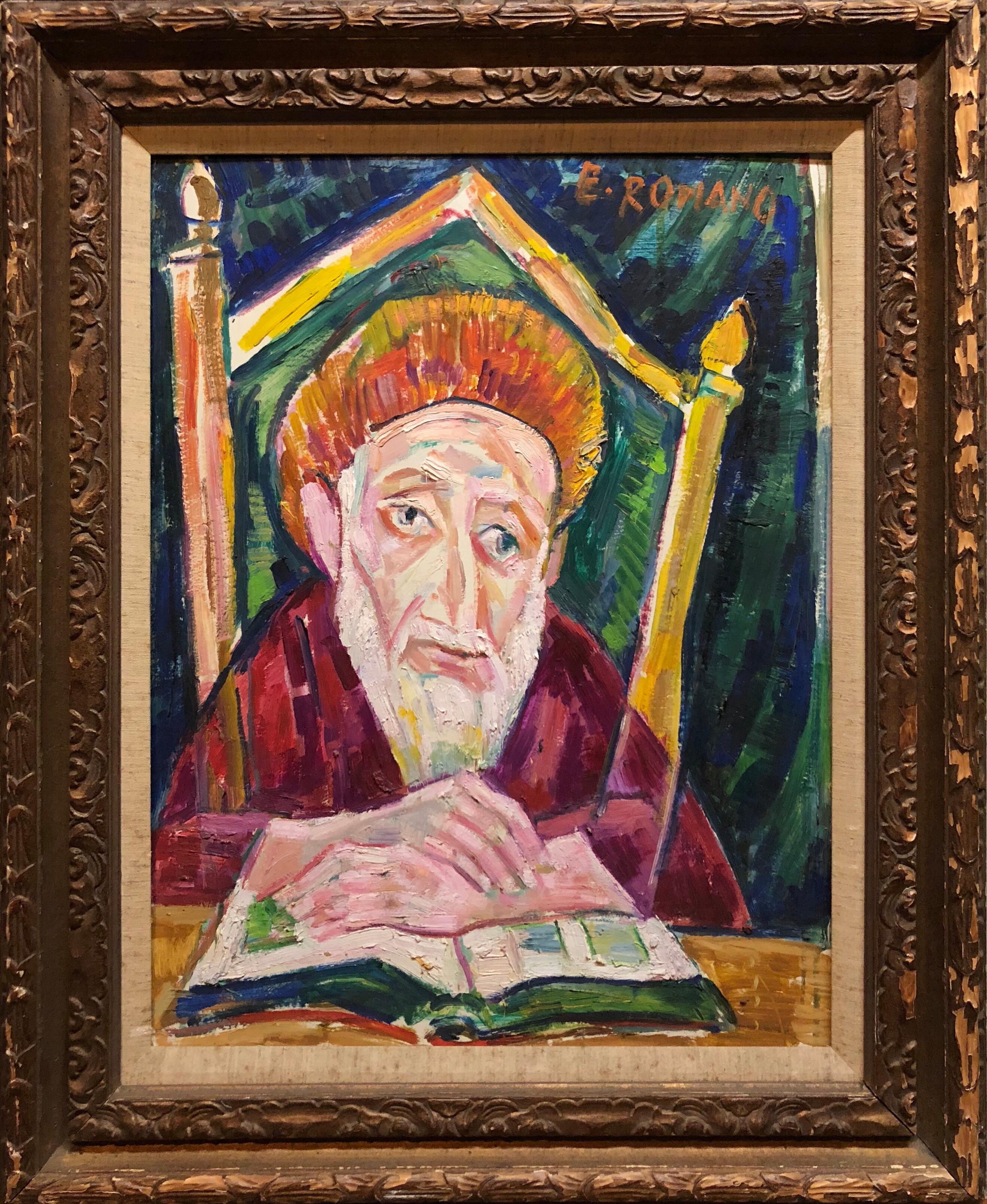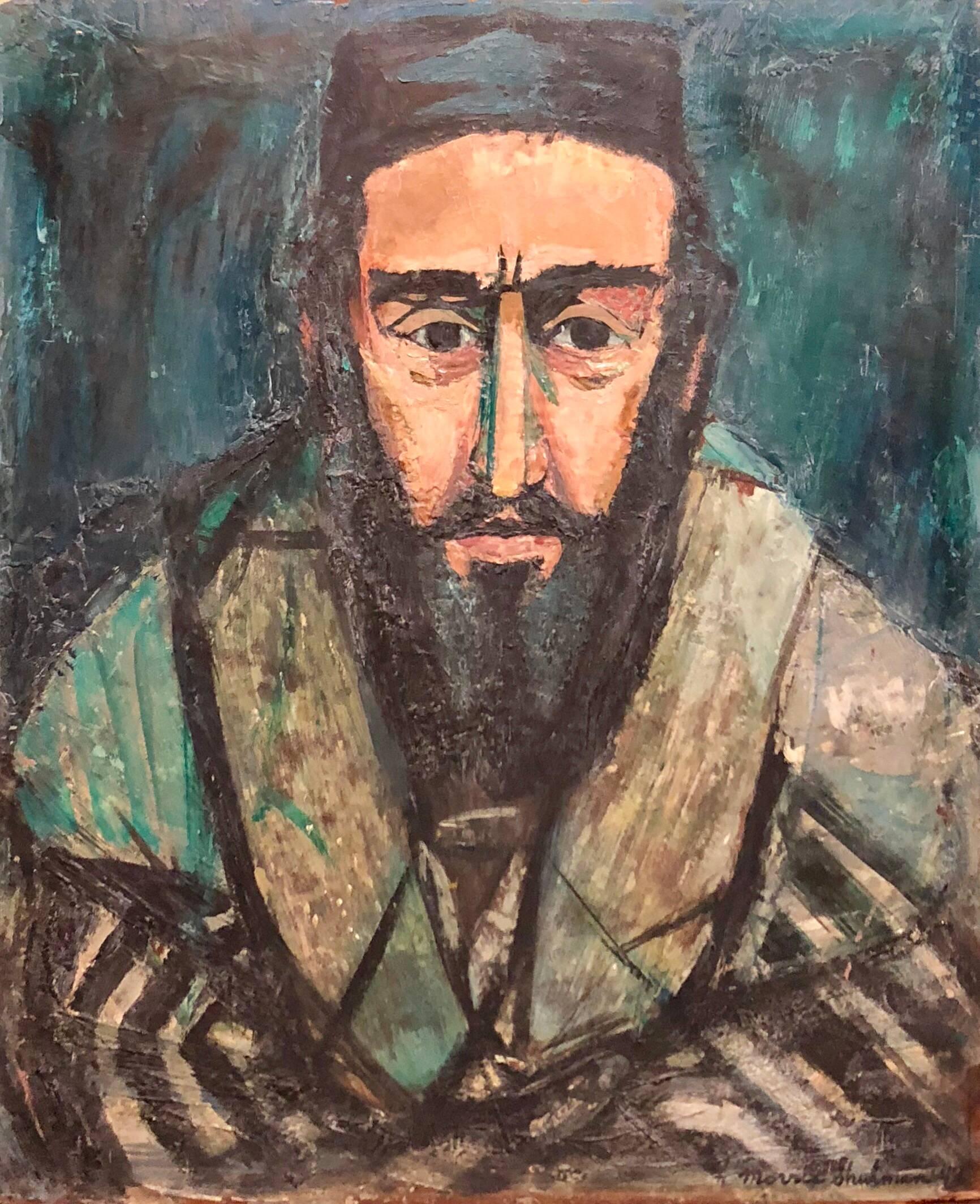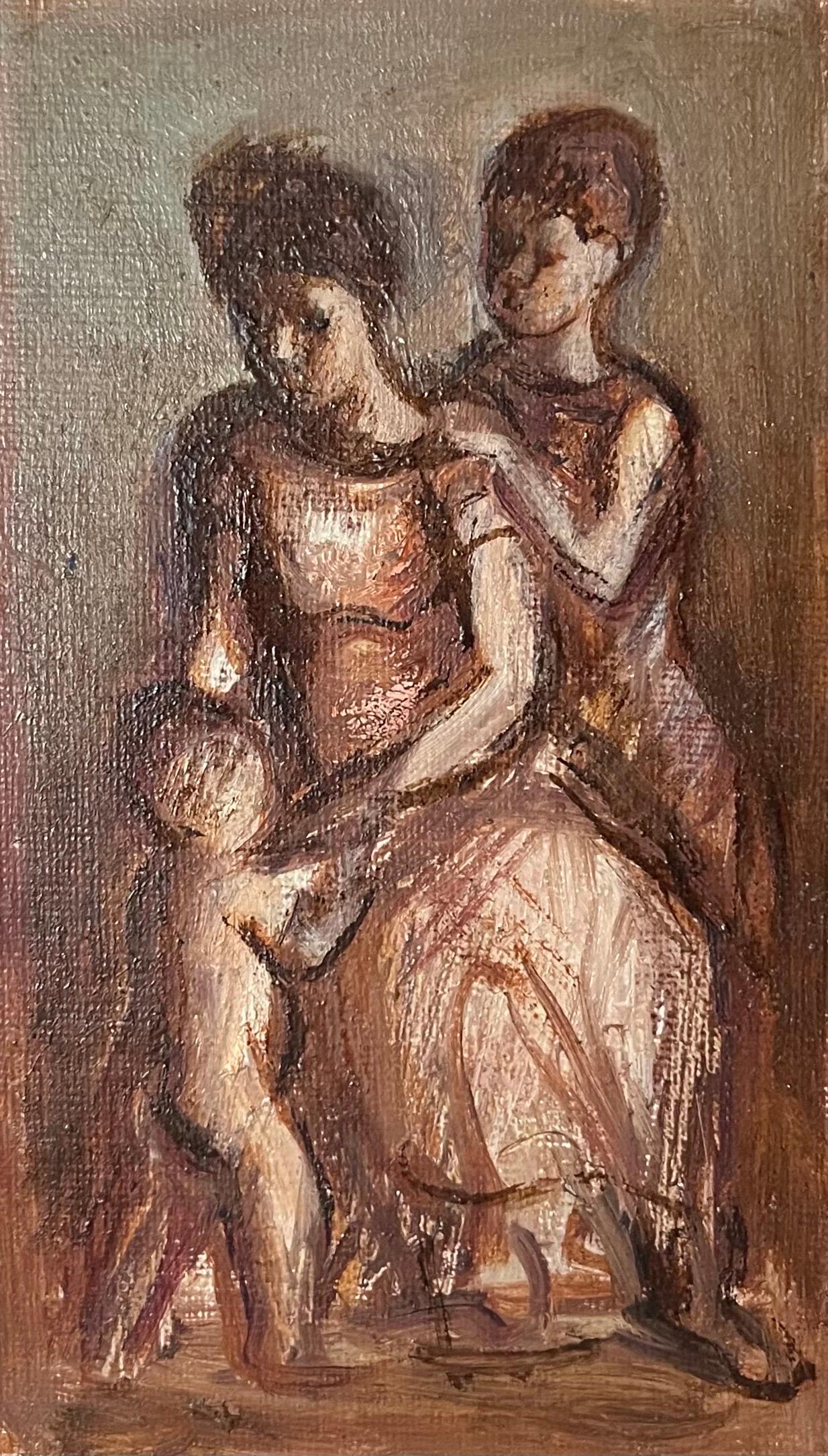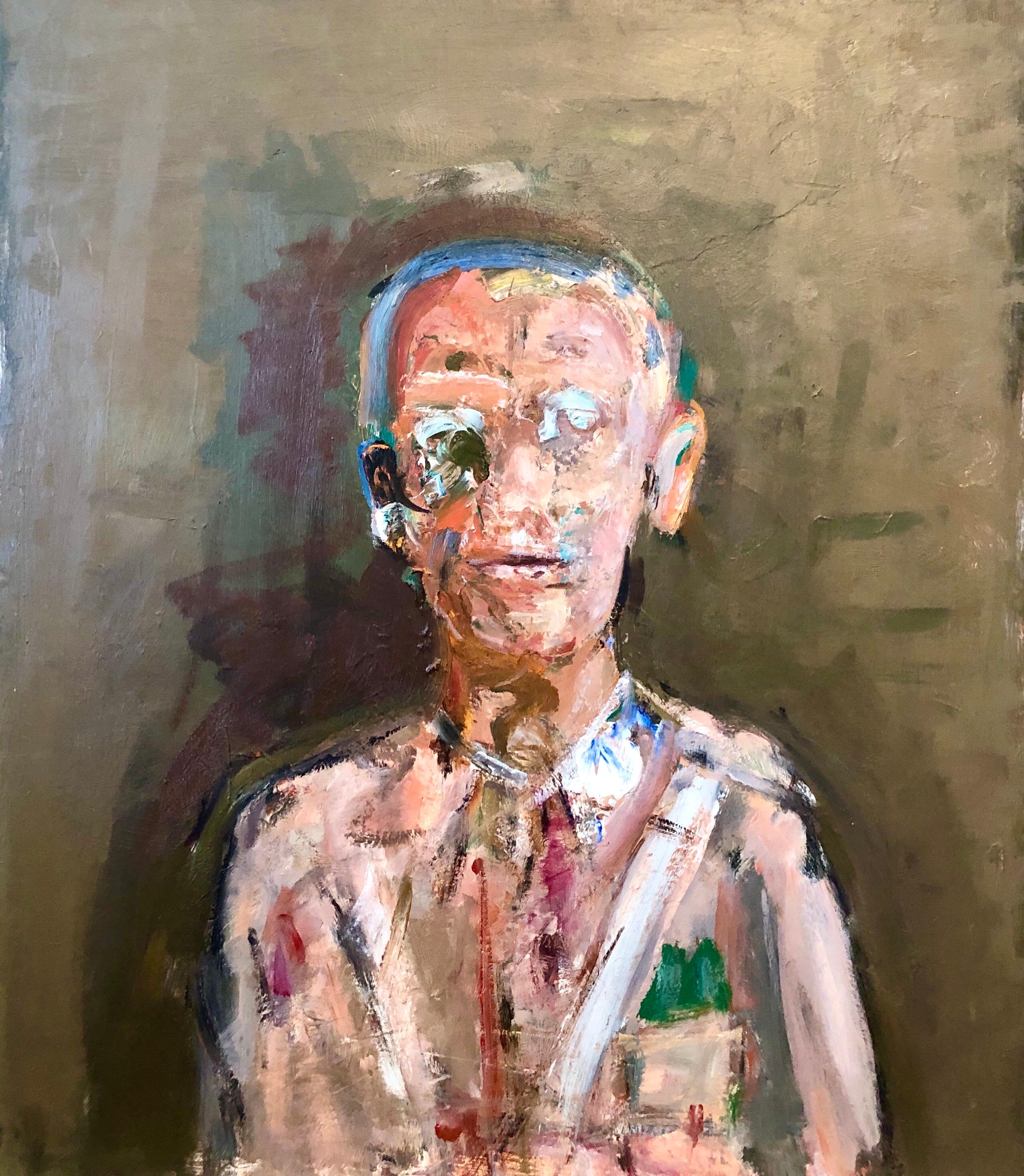Items Similar to Modernist American Judaica Painting Gaon and his Disciples
Want more images or videos?
Request additional images or videos from the seller
1 of 8
Ervin B. NussbaumModernist American Judaica Painting Gaon and his Disciples
About the Item
In this painting, Nussbaum portrays a Rabbi, or Rebbe outside the synagogue The vibrant colors used in this painting seem to overlay each other without being previous mixed.
Ervin B. Nussbaum was born in Columbus, Ohio on November 11, 1914. His father, Marger, had arrived as part of the great Russian Diaspora of the time, when many Jewish families settled in Ohio, particularly in the Columbus area.
Nussbaum attended Ohio State University during the Great Depression and continued to live in Ohio until America’s involvement in World War II. His oil painting The End of John Brown, which depicts a fictionalization of the American abolitionist’s final hours, won first prize at the Central Ohio Competition in 1941. The piece then toured the country stopping at the San Francisco Museum, the Butler Art Institute, the Philadelphia Academy and the Corcoran Gallery. Donated in 2001, the painting is now part of the permanent collection at the Torrington Historical Society in Torrington, Connecticut, John Brown’s birthplace.
When the war began, Ervin, along with some 40,000 other men of all faiths, became part of the conscientious objector program known as the Civil Public Service. He spent the years 1942 through 1946 interned in government camps from New Hampshire to Maryland, working in public services such as forestry and hurricane cleanup. Many other objectors housed alongside him were of artistic inclination and shared Nussbaum’s conviction of peace, so artistic pursuits were common within these camps.
During these early years, his paintings followed a somewhat whimsical figurative style and leaned towards patriotic and Hebraic themes. In time, these themes began to take on an almost Cubist feel and eventually leaned toward complete abstraction.
Upon his release from his voluntary conscription as a CPS, Nussbaum moved to New York where he frequently painted semi-abstract landscapes in the local parks, throughout the New England countryside, and at the shorelines. He especially enjoyed painting in the woodland tranquility of Inwood Park in northern Manhattan. He paid special attention to the park’s bird life, which would soon become a new favorite subject. Their graceful movement inspired his creation of a series of avian sculptures in wood, metal or mixed medias.
In 1951, he met the dynamic young actress, playwright, musician, and graphic artist Muriel Leventhal. They married and moved to Norwalk, Connecticut in 1959. Nussbaum continued to work in a variety of media and showed regularly in many different galleries throughout Connecticut. His bronze sculpture Three Girls on a Flower was commissioned by the Trumbull Library and a wood bas-relief was created for the sanctuary at the Yonkers Temple Emanuel. Nussbaum would remain in Norwalk until his death in 1996.
When contemplating the work of Ervin Nussbaum, we find the soul of a man set in principles of profound religious and patriotic convictions as well as a deep abiding love of nature. His art shows us the evolution of the man through the evolution of the styles he undertook during his lifetime; from figurative, to cubist, to complete abstraction; from oils, to charcoal, to a mixture of media. His works are left to us in museums across the United States, as well as in countless private collections in the U.S. and abroad.
- Creator:Ervin B. Nussbaum (1914-1996, American)
- Dimensions:Height: 19.75 in (50.17 cm)Width: 27.75 in (70.49 cm)
- Medium:
- Movement & Style:
- Period:
- Condition:Slight wear, consistent with age.
- Gallery Location:Surfside, FL
- Reference Number:1stDibs: LU38211147902
About the Seller
4.9
Platinum Seller
These expertly vetted sellers are 1stDibs' most experienced sellers and are rated highest by our customers.
Established in 1995
1stDibs seller since 2014
1,550 sales on 1stDibs
Typical response time: 1 hour
- ShippingRetrieving quote...Ships From: Surfside, FL
- Return PolicyA return for this item may be initiated within 3 days of delivery.
More From This SellerView All
- Modernist Oil Painting 1940s, Judaica Hasidic Rabbi in JerusalemBy Emanuel Glicenstein RomanoLocated in Surfside, FLGenre: Portrait Subject: Landscape Medium: Oil Surface: Board Country: United States EMANUEL ROMANO Rome, Italy, b. 1897, d. 1984 Emanuel Glicenstein Romano was born in Rome, September 23, 1897. His father Henryk Glicenstein was a sculptor and was living in Rome with his wife Helena (born Hirszenberg) when Emanuel was born. His father obtained Italian citizenship and adopted the name Enrico. Emanuel was brought up in Italy, Switzerland, Germany, England and Poland. In 1926 Emanuel and his father sailed for New York. They briefly visited Chicago. Romano's sister, Beatrice, and mother only joined them in New York years later. Romano changed his name on his arrival to America and some have erroneously speculated that this was to avoid antisemitic discrimination. In truth, as the son of a highly-regarded artist, Romano changed his name to ensure that any success or recognition he would later attain, would be the result of nothing other than his own merit as an artist, and not on account of his father's fame. In 1936 Romano was worked for the Federal Art Project creating murals. During and immediately after World War II, Romano created a series of allegorical works depicting graphic holocaust images that were held closely by the family until after his passing. One of these works is now on permanent display in the Florida Holocaust Museum in St. Petersburg Florida. Emanuel's father died in 1942 in a car accident before they could realize their shared dream of visiting Israel. In 1944 Romano, having completed his degree at the Pennsylvania Academy of Fine Arts and the Art Institute of Chicago, began teaching at the City College of New York. Romano moved to Safed, Israel in 1953 and established an art museum in his father's memory, the Glicentein Museum. COLLECTIONS Indianapolis Museum of Art Metropolitan Museum of Art Boston Fine Arts Museum Fogg Museum Musée Nacional de France Recently his work has been added to the Florida Holocaust Museum collection. His notable works include his holocaust themed allegorical paintings as well as portraits of Marianne Moore, his father and William Carlos Williams...Category
1970s American Modern Figurative Paintings
MaterialsOil, Board
- Judaica Rabbi Portrait Oil Painting American WPA Abstract Expressionist ArtistBy Morris ShulmanLocated in Surfside, FLBorn in Savannah, Georgia in 1912, abstract expressionist painter Morris Shulman studied at the National Academy of Design, Art Students League and Hans Hofmann School of Art in New ...Category
1940s American Modern Portrait Paintings
MaterialsEncaustic, Oil, Board
- Simka Simkhovitch WPA Artist Oil Painting Family Mother, Kids American ModernistBy Simka SimkhovitchLocated in Surfside, FLSimka Simkhovitch (Russian/American 1893 - 1949) This came with a small grouping from the artist's family, some were hand signed some were not. These were studies for larger paintings. Simka Simkhovitch (Симха Файбусович Симхович) (aka Simka Faibusovich Simkhovich) (Novozybkov, Russia May 21, 1885 O.S./June 2, 1885 N.S.—Greenwich, Connecticut February 25, 1949) was a Ukrainian-Russian Jewish artist and immigrant to the United States. He painted theater scenery in his early career and then had several showings in galleries in New York City. Winning Works Progress Administration (WPA) commissions in the 1930s, he completed murals for the post offices in Jackson, Mississippi and Beaufort, North Carolina. His works are in the permanent collections of the Dallas Museum of Art, the National Museum of American Art and the Whitney Museum of American Art. Born outside Kyiv (Petrograd Ukraine) into a Jewish family who owned a small department store. During a severe case of measles when he was seven, Simcha Simchovitch sketched the views outside his window and decided to become an artist, over his father's objections. Beginning in 1905, he studied at the Grekov Odessa Art School and upon completion of his studies in 1911 received a recommendation to be admitted to the Imperial Academy of Arts. Though he enrolled to begin classes in architecture, painting, and sculpture at the Imperial Academy, he was dropped from the school roster in December because of the quota on the number of Jewish students and drafted into the army. Simchovitch served as a private in the 175th Infantry Regiment Baturyn [ru] until his demobilization in 1912. Re-enrolling in the Imperial Academy, he audited classes. Simka Simkhovitch exhibited paintings and sculptures in 1918 as part of an exhibition of Jewish artists and in 1919 placed 1st in the competition "The Great Russian Revolution" with a painting called "Russian Revolution" which was hung in the State Museum of Revolution. In 1922, Simkha Simkhovitch exhibited at the International Book Fair in Florence (Italian: Fiera Internazionale del Libro di Firenze). In 1924, Simkhovitch came to the United States to make illustrations for Soviet textbooks and decided to immigrate instead. Initially he supported himself by doing commercial art and a few portrait commissions. In 1927, he was hired to paint a screen for a scene in the play "The Command to Love" by Fritz Gottwald and Rudolph Lothar which was playing at the Longacre Theatre on Broadway. Art dealers began clamoring for the screen and Simkhovitch began a career as a screen painter for the theater. Catching the attention of the screenwriter, Ernest Pascal, he worked as an illustrator for Pascal, who then introduced him to gallery owner, Marie Sterner. Simkhovitch's works appeared at the Marie Sterner Gallery beginning with a 1927 exhibit and were repeated the following year. Simkhovitch had an exhibit in 1929 at Sterner's on circus paintings. In 1931, he held a showing of works at the Helen Hackett Gallery, in New York City and later that same year he was one of the featured artists of a special exhibit in San Francisco at the California Palace of the Legion of Honor in Lincoln Park. The exhibit was coordinated by Marie Sterner and included four watercolors, including one titled "Nudes". He is of the generation of Russian Soviet artists such as Isaac Pailes, Serge Charchoune, Marc Chagall, Chana Orloff, Isaac Ilyich Levitan, and Ossip Zadkine. In 1936, Simkhovitch was selected to complete the mural for the WPA Post office project in Jackson, Mississippi. The mural was hung in the post office and courthouse in 1938 depicted a plantation theme. Painted on the wall behind the judge’s bench, “Pursuits of Life in Mississippi”, a depiction of black workers engaged in manual labor amid scenes of white professionals and socialites, was eventually covered over in later years during renovations due to its stereotypical African American imagery. The following year, his painting "Holiday" won praise at an exhibition in Lincoln, Nebraska. In 1940, Simkhovitch's second WPA post office project was completed when four murals, "The Cape Lookout Lighthouse and the Orville W. Mail Boat", "The Wreck of the Crissie Wright", "Sand Ponies" and "Canada Geese" were installed in Beaufort, North Carolina. The works were commissioned in 1938 and did not generate the controversy that the Jackson mural had. The main mural is "The Wreck of the Crissie Wright" and depicts a shipwreck which had occurred in Beaufort in 1866. "The Cape Lookout Lighthouse and the Orville W. Mail Boat" depicted the lighthouse built in 1859 and the mail boat that was running mail during the time which Simkhovitch was there. The boat ran mail for the area until 1957. "Sand Ponies" shows the wild horses common to the North Carolina barrier islands and "Canada Geese" showed the importance of hunting and fishing in the area. All four murals were restored in the 1990s by Elisabeth Speight, daughter of two other WPA muralists, Francis Speight...Category
1930s American Modern Figurative Paintings
MaterialsOil, Board
- Simka Simkhovitch WPA Artist Oil Painting Family Mother, Kids American ModernistBy Simka SimkhovitchLocated in Surfside, FLSimka Simkhovitch (Russian/American 1893 - 1949) This came with a small grouping from the artist's family, some were hand signed some were not. These were studies for larger paintings. Simka Simkhovitch (Симха Файбусович Симхович) (aka Simka Faibusovich Simkhovich) (Novozybkov, Russia May 21, 1885 O.S./June 2, 1885 N.S.—Greenwich, Connecticut February 25, 1949) was a Ukrainian-Russian Jewish artist and immigrant to the United States. He painted theater scenery in his early career and then had several showings in galleries in New York City. Winning Works Progress Administration (WPA) commissions in the 1930s, he completed murals for the post offices in Jackson, Mississippi and Beaufort, North Carolina. His works are in the permanent collections of the Dallas Museum of Art, the National Museum of American Art and the Whitney Museum of American Art. Born outside Kyiv (Petrograd Ukraine) into a Jewish family who owned a small department store. During a severe case of measles when he was seven, Simcha Simchovitch sketched the views outside his window and decided to become an artist, over his father's objections. Beginning in 1905, he studied at the Grekov Odessa Art School and upon completion of his studies in 1911 received a recommendation to be admitted to the Imperial Academy of Arts. Though he enrolled to begin classes in architecture, painting, and sculpture at the Imperial Academy, he was dropped from the school roster in December because of the quota on the number of Jewish students and drafted into the army. Simchovitch served as a private in the 175th Infantry Regiment Baturyn [ru] until his demobilization in 1912. Re-enrolling in the Imperial Academy, he audited classes. Simka Simkhovitch exhibited paintings and sculptures in 1918 as part of an exhibition of Jewish artists and in 1919 placed 1st in the competition "The Great Russian Revolution" with a painting called "Russian Revolution" which was hung in the State Museum of Revolution. In 1922, Simkha Simkhovitch exhibited at the International Book Fair in Florence (Italian: Fiera Internazionale del Libro di Firenze). In 1924, Simkhovitch came to the United States to make illustrations for Soviet textbooks and decided to immigrate instead. Initially he supported himself by doing commercial art and a few portrait commissions. In 1927, he was hired to paint a screen for a scene in the play "The Command to Love" by Fritz Gottwald and Rudolph Lothar which was playing at the Longacre Theatre on Broadway. Art dealers began clamoring for the screen and Simkhovitch began a career as a screen painter for the theater. Catching the attention of the screenwriter, Ernest Pascal, he worked as an illustrator for Pascal, who then introduced him to gallery owner, Marie Sterner. Simkhovitch's works appeared at the Marie Sterner Gallery beginning with a 1927 exhibit and were repeated the following year. Simkhovitch had an exhibit in 1929 at Sterner's on circus paintings. In 1931, he held a showing of works at the Helen Hackett Gallery, in New York City and later that same year he was one of the featured artists of a special exhibit in San Francisco at the California Palace of the Legion of Honor in Lincoln Park. The exhibit was coordinated by Marie Sterner and included four watercolors, including one titled "Nudes". He is of the generation of Russian Soviet artists such as Isaac Pailes, Serge Charchoune, Marc Chagall, Chana Orloff, Isaac Ilyich Levitan, and Ossip Zadkine. In 1936, Simkhovitch was selected to complete the mural for the WPA Post office project in Jackson, Mississippi. The mural was hung in the post office and courthouse in 1938 depicted a plantation theme. Painted on the wall behind the judge’s bench, “Pursuits of Life in Mississippi”, a depiction of black workers engaged in manual labor amid scenes of white professionals and socialites, was eventually covered over in later years during renovations due to its stereotypical African American imagery. The following year, his painting "Holiday" won praise at an exhibition in Lincoln, Nebraska. In 1940, Simkhovitch's second WPA post office project was completed when four murals, "The Cape Lookout Lighthouse and the Orville W. Mail Boat", "The Wreck of the Crissie Wright", "Sand Ponies" and "Canada Geese" were installed in Beaufort, North Carolina. The works were commissioned in 1938 and did not generate the controversy that the Jackson mural had. The main mural is "The Wreck of the Crissie Wright" and depicts a shipwreck which had occurred in Beaufort in 1866. "The Cape Lookout Lighthouse and the Orville W. Mail Boat" depicted the lighthouse built in 1859 and the mail boat that was running mail during the time which Simkhovitch was there. The boat ran mail for the area until 1957. "Sand Ponies" shows the wild horses common to the North Carolina barrier islands and "Canada Geese" showed the importance of hunting and fishing in the area. All four murals were restored in the 1990s by Elisabeth Speight, daughter of two other WPA muralists, Francis Speight...Category
1930s American Modern Figurative Paintings
MaterialsOil, Board
- Military Man Portrait Figurative Abstract Oil Painting American Modernist ArtistBy Dean RichardsonLocated in Surfside, FLOil on board, 1978. It depicts an abstracted portrait of a military man in an army uniform with medals. It is signed by the artist verso. Dimensions: sight size-22 inches tall X 19 1/4 inches wide. Framed-23 1/4 inches tall X 20 5/8 inches wide. All measurements are approximate. Dean Richardson...Category
1970s American Modern Figurative Paintings
MaterialsOil, Board
- Rare Polish American 1930s Oil Painting Painting WPA Russian Babushka Jewish ArtBy Abram TromkaLocated in Surfside, FLAbram Tromka was born May 1, 1896 in Poland. At the age of seven he immigrated with his family to the United States, settling in New York City. It was on the boat coming to New York where Tromka first became interested in art. Fascinated by a woman who was painting, he decided that he wanted to become an artist. Upon arrival at immigration headquarters, Tromka’s family adopted the surname “Phillips,” which he kept until 1930. Hence the artist’s early works bear the signature — ‘Phillips.’ Having a rough childhood, Tromka left home at 15 and spent the remainder of his teenage years living at the Henry Street...Category
1930s American Modern Figurative Paintings
MaterialsOil, Board
You May Also Like
- Self Portrait, Oil on Board, Signed and Dated, 1925, American ModernistBy Leon KellyLocated in Doylestown, PA"Self Portrait" by Philadelphia born modernist painter Leon Kelly, is a moody and atmospheric self portrait of the artist in younger years at age 24. The 18" x 16" oil on board, fram...Category
1920s American Modern Portrait Paintings
MaterialsOil, Board
- America impressionist portrait young boy 1937 Modern Figurative Oil PaintingLocated in Buffalo, NYA fantastic modern portrait of a young boy. This work is signed what appears to be Paul Sellers and dated 1937, but we have not found information on the artist. The work dated 1936...Category
1930s American Modern Figurative Paintings
MaterialsOil, Board
- Portrait of Eugene Higgins, Age 80.By Alphaeus Philemon ColeLocated in Storrs, CTPortrait of Eugene Higgins, Age 80. 1954. Oil on canvas. 30 x 25 (framed 35 x 30). Signed and dated lower right. Cole and Higgins (1874-1958), both lived in Lyme, Connecticut. Higg...Category
1950s American Modern Portrait Paintings
MaterialsOil
- Mid-Century Modern Man - Portrait in Oil on CanvasLocated in Soquel, CASubtle and moody portrait of a Pensive man by Joan Tidwell (American, 1930-2002). The sitter in the portrait is a middle-aged man looking slightly downwards, wearing a collared shirt. This piece is completed in a tan and green palette, creating a somber feeling. Of particular note are the confident, thick brushstrokes - each one is well-placed in the modernist style. Similar in some ways to Picasso's portraits. Signed "Joan Tidwell" on verso Unframed. Canvas size: 30"H x 22"W oan Gay Tidwell (American, 1930-2002) was born and raised in Hollywood, CA, where she had some success as a child actor. Later, she graduated Magna Cum Laude from the University of Washington with a Master's Degree in English Literature and Drama. Tidwell moved to the Bay...Category
1960s American Modern Portrait Paintings
MaterialsCanvas, Oil
- Modern Portrait of Young Girl "Cathy" Oil on CanvasBy Patricia Gren HayesLocated in Soquel, CAModern portrait of young girl named Cathy Gutman by American painter, Patricia Gren Hayes (b. 1932), 1982. Signed and dated lower left corner and on verso Provenance: Purchased as part of larger collection of artist's work from the estate of Larry Miller fine Art Unframed. Canvas size: 18"H x 16"W. Patricia Gren Hayes (American, b. 1932) is a Bay Area Figurative & Feminist Art Movement artist who studied at Winnipeg Public Art School in 1950. She received early recognition in Museum and Gallery competitions and exhibitions and was awarded a Special Education in Art recognition by the Winnipeg Museum of Fine Art, and was awarded a scholarship to the Banff College of Fine Art. Further studies were at The University of Manitoba. She was a Member of Winnipeg Free Press Sketch Club and was a Cartoonist and paste-up for a French-English bi-weekly, in Eastern Canada; She studied outdoor impressionism in New York in 1960; in 1962, attended The California College of Arts and Crafts, and in 1976 B.A., U.C. Berkeley where she studied under Elmer Bischoff, David Simpson, Joan Brown, Felix Ruvolo, Yolanda Lopez and Vincent Perez. She started a freelance commercial art business in 1963; copyrighted a National Cartoon, 1976, and served as Exhibition Director for San Francisco Woman Artists Gallery and the San Francisco Museum of Modern Art, 1976-1978. She was a workshop instructor at the San Francisco Woman Artists Gallery, 1977-1985; and was Manager/Owner Stanton Art Gallery, Alameda, CA, 1976-1982. Solo Exhibitions: Berkeley Marina, 1974; Oakland Center for The Visual Arts, "Images of Women", 1979 Group Exhibitions: Oakland's Dept of Education, 1963, Studio One; Alameda County Fair, 1975, 1976, 1978; San Francisco Art Festival, 1969, 1970, 1976, 1977, 1978; San Francisco Museum of Modern Art, 1976, 1977, 1978; San Francisco Women Artists Gallery Exhibition, award winner - 1970, 1977, 1978; Hayward Bay Fair Art Festival, award winner - 1971; Capricorn Assunder Gallery, 1973; Oakland Art Festival, 1973, 1974; Alameda Art Association, 1978; El Cerrito...Category
1980s American Modern Figurative Paintings
MaterialsOil, Canvas
- Modernist Unfinished Portrait -- Handsome Man in Dress UniformBy Patricia Gren HayesLocated in Soquel, CAModern unfinished portrait of handsome man in dress uniform by American painter, Patricia Gren Hayes (b. 1932), circa 1970. Unsigned. Provenance: Purchased as part of larger collection of artist's work from the estate of Larry Miller Unframed. Canvas size: 30"H x 36"W. Patricia Gren Hayes (American, b. 1932) is a Bay Area Figurative & Feminist Art Movement artist who studied at Winnipeg Public Art School in 1950. She received early recognition in Museum and Gallery competitions and exhibitions and was awarded a Special Education in Art recognition by the Winnipeg Museum of Fine Art, and was awarded a scholarship to the Banff College of Fine Art. Further studies were at The University of Manitoba. She was a Member of Winnipeg Free Press Sketch Club and was a Cartoonist and paste-up for a French-English bi-weekly, in Eastern Canada; She studied outdoor impressionism in New York in 1960; in 1962, attended The California College of Arts and Crafts, and in 1976 B.A., U.C. Berkel...Category
1970s American Modern Figurative Paintings
MaterialsOil, Canvas
Recently Viewed
View AllMore Ways To Browse
Foral Modernist Paintings
American Modernist Paintings
American Vintage Library
American Art Paintings Of New England
World War Ii American
Figurative Historical Paintings
Early Modernist Painting
Civil War America
Civil War Of America
Public Park Painting
Maryland Painting
Paintings Of Maryland
War B
American Government
Nature 20th Century America
Modern Jewish Painting
House In Woods American Paintings
Paintings Of Civil War





